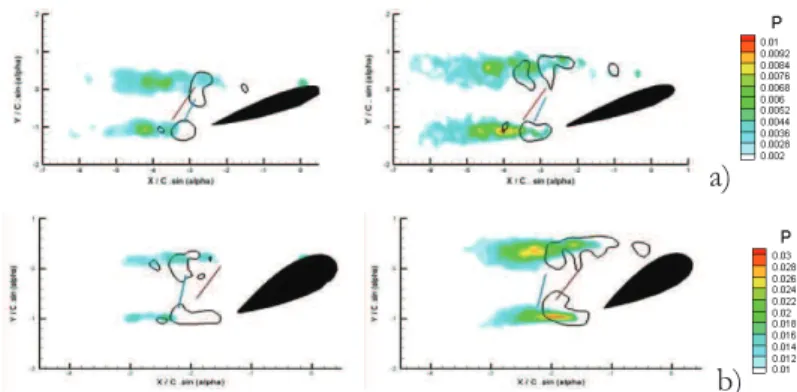To cite this document: Prothin, Sebastien and Djeridi, Henda and Billard, Jean-Yves
Physical analysis of the coherent motion during hysteretic static stall of Naca foil using
proper orthogonal decomposition. (2009) In: Second International conference on high
Reynolds number vortex interactions, 31 August 2009 - 02 September 2009 (Brest,
France).
O
pen
A
rchive
T
oulouse
A
rchive
O
uverte (
OATAO
)
OATAO is an open access repository that collects the work of Toulouse researchers and makes it freely available over the web where possible.
This is an author-deposited version published in: http://oatao.univ-toulouse.fr/
Eprints ID: 9870
Any correspondence concerning this service should be sent to the repository administrator: staff-oatao@inp-toulouse.fr
Physical analysis of the coherent motion during hysteretic
static stall of Naca foil using proper orthogonal decomposition.
S. Prothina, H. Djeridib, J-Y Billarda
a. Institut de Recherche de l’Ecole Navale (IRENav EA 3634), Département Mécanique et Energétique en Environnement Naval, CC 400, 29240 BREST Cedex 9
b. Laboratoire de Physique des Océans (LPO, UMR 6523, CNRS, IFREMER, IRD, UBO), Université Européenne de Bretagne, Université de Brest / UFR Science, 6 Av. Le Gorgeu, BP 809, 29285 Brest Cedex.
At static stall of airfoil, an hysteretic behavior (corresponding to an abrupt loss of lift) has been observed leading to a partially detached flow (called state I, upper increasing angle branch) and massively separated flow (called state II, lower decreasing angle branch). In order to predict the type of hysteretic loop that may occur or to quantify unsteady oscillatory flow in the near wake, experiments have been performed to explore laminar separation, transition and detachment of the boundary layer (Mittal and Saxena, 2000) but the key-physical properties of the vortex shedding establishment during hysteretic loop is not clearly understood. During this hysteretic loop, a particular vortex dynamics is observed corresponding to an interaction of the alternating leading and trailing edge vortices. In the present study, experiments have been conducted using LDV and PIV techniques to quantify the topology of the unsteady separated flow in the near wake and the shear layer of 2D Naca (15, 25, 35%) symmetric hydrofoils at Reynolds number 0.5 105. As expected a pattern of two eddies is obtained due to the averaging of the passage of the alternating vortices (cyclonic and anticyclonic vortices) but the state II is characterized by a thickening effect in vertical direction and a modification of characteristic lengths of the wake depending on the thickness of the foil. The main difference between the two states concerns the topology and the dynamics of the vortices associated with the transport of anticyclonic vortices. At state I, vortices are dissymmetric (elliptical and distorted vortex) and the trailing edge vortex is less developed compared to the leading edge vortices (anticyclonic vortices are strongly stretched). At the passage of state II, the anticyclonic vorticity region extends on a larger area and leads to a classical value of Strouhal number 0.2 as Karman street (Djeridi et al. 2003). On the other hand, small scale perturbations, in comparison with the vortex size, growth in the core of anticyclonic vorticity. Indeed, the lower branch of hysteresis (state II) is characterized by a predominance of strain rate and an increase of turbulent production term in the wake due to the longitudinal and vertical transport of the trailing edge vortices (figure 1). The diffusion of the anticyclonic vortices has been observed using Q criterion:
) 2 2 ( 2 1 S
Q= Ω − (Jeong and Hussain 1995, Hunt et al. 1988) in order to propose a local definition based on a non-intuitive concept. To point out the contribution of the mean motion on the turbulent production at small scales, proper orthogonal decomposition of velocity field using snapshot method (Sirovich, 1987) has
been used (figure 2; ). Indeed, this method allows an
extraction of the vortex pattern comparing with that obtained by Reynolds averaging. Taking into account the non time-resolved PIV measurements, only the spatial physical process is projected on the Karhunen-Loewe base and allows to decompose turbulent flow into coherent non-Gaussian component and random part of the motion (u(x) u( )(x) ui(r)(x)
c i
i = + = ). As expected, the two first
modes exhibit clearly the convection of the vortices and 10 modes are necessary for the field reconstruction. The small amplitudes of the reconstructed random part of the flow compared to the Reynolds averaging turbulent intensity, show that the turbulent production is essentially issue from the mean motion of anticyclonic vortices. The so-called random motion obtained by Reynolds averaging is due not only to the background turbulent motion but also to the realignment of the trailing edge vortices from state II (figure 3).
FIG. 1– Turbulent production Iso-contours P12(contours Q=0.5).
a) Naca 0015 state I (left), state II (right); b) Naca 0035 state I (left), state II (right).
State I mode 1 mode 2 mode 3 mode 4 ; State II, mode 1 mode 2 mode 3 mode 4
FIG. 2 – Streamlines of spatial mode of POD.
FIG. 3 – Iso-contours of u'2 /Uinf . Original turbulent intensity (left), reconstructed random part for 30 to 1000 spatial modes (right)
References
Djeridi H., Braza M., Perrin R., Harran G., Cid E., Cazin S.: “Near wake turbulence around a circular
cylinder at high Reynolds number”, Journal of Flow Turbulence and Combustion, volume 71, pp 19-34,
Editions Kluwer Academic Publishers, 2003.
Hunt J.C.R., Wray A.A., and Moin P. :“Eddies, stream and convergence zones in turbulent flows”. Technical Report CTR-S88, Center for Turbulence Research, 1988.
Jeong J., Hussain F.: “On the identification of a vortex”. Journal of Fluid Mechanics, vol 285, 1995.
Mittal S., Saxena P.: “Prediction of hysteresis associated with the static stall of an airfoil”. AIAA Journal, vol 38 n°5, 2000.
Sirovich L.: “Turbulence and the dynamics of coherent structures”. Parts I, II & III. Quarterly of Applied Mathematics, XLV(3) :561–582, 1987.
